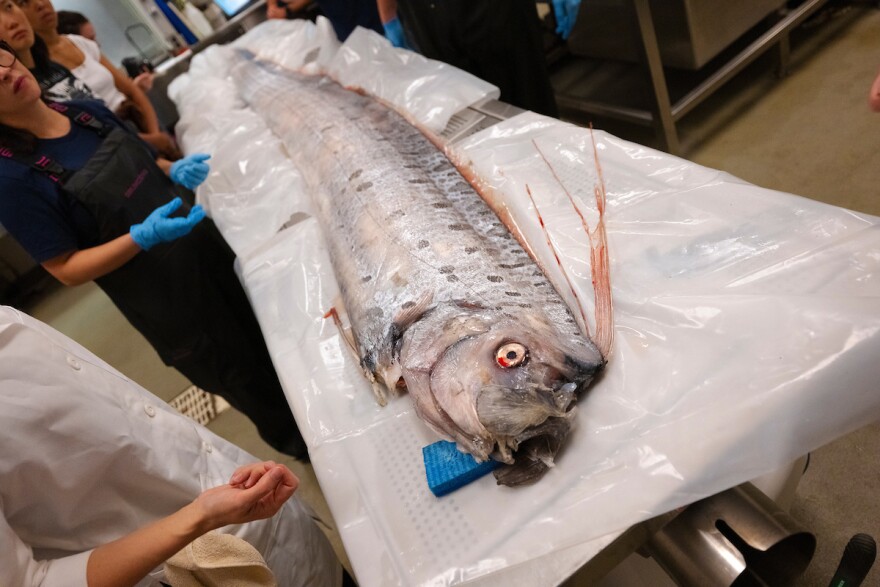Scientists at UC San Diego's Scripps Institution of Oceanography have completed a necropsy on a deep-sea oarfish, which washed up earlier this month, providing a rare look and scientific data, it was announced Thursday.
Kayakers and snorkelers in La Jolla Cove ran into the already dead fish on Aug. 10 — just the 20th of its species documented to have washed up on California beaches since 1901.
The fish was transported to the NOAA Fisheries' Southwest Fisheries Science Center in La Jolla. On Friday, a team of scientists from UCSD, Cal State Fullerton, and NOAA were able to examine the short-crested oarfish, performing a necropsy, or animal autopsy, to learn more about the organism.
"Rare encounters like this provide an amazing opportunity to learn more about this species and how it lives," said Ben Frable, ichthyologist and manager of the Marine Vertebrate Collection at Scripps, and part of the necropsy team. "We are fortunate to have a large community of researchers and world-class collection that mobilized quickly to examine and preserve this fish."
The fish was an adult male, measuring 12.25 feet long, 1.14 feet in depth and weighing in at 74.3 pounds. The fish has a scaleless, long ribbon- like silvery body with dark spots. A long red dorsal fin crest, measuring 2.17 feet in length, extended from the top of the head, according to the necropsy data.
Often described as sea serpents in history, oarfish can grow to lengths of 30 feet and are the longest bony fish in the world. Oarfish have a mythical reputation as predictors of natural disasters and earthquakes.
Scientists do not know why the fish — which looked to be in good condition — washed up where it did, though it is generally thought to have to do with injury, illness and disorientation. Frable said that La Jolla Shores is situated next to two underwater canyons that funnel deep water close to shore.
Samples from the fish will be used for several purposes, including:
— Mapping the first high-quality, chromosome-level genome for the longest bony fish in the world;
— Using stable isotopes and genetic barcoding to better understand foraging ecology, or what the fish is eating and its role in the marine food web;
— Describing the shape and function of the gills and gill rakers — the elements that the fish use to filter their prey from the water — to look at the filtering anatomy and to inform studies of metabolism and feeding strategies; and
— Describing the reproductive status. This male did not have visible signs of milt (sperm) and scientists have previously found that oarfish locally are reproducing in June, but not August or September.
Additionally, researchers will analyze organs, tissues and body fluids for potential presence of contaminants such as microplastics and DDT and compare its digestive system with the other species of oarfish.
"This oarfish presents a rare opportunity to obtain fresh samples for genomic analysis, allowing us to study the evolutionary adaptations that enable this species to thrive in deep-sea environments," said Dahiana Arcila, marine biologist and curator of the Marine Vertebrate Collection at Scripps. "This finding also significantly contributes to documenting life on our planet, with each specimen providing valuable data to guide conservation efforts and enhance our understanding of marine ecosystems.
"Collections like ours play a crucial role in preserving these specimens for future research, ensuring that we can continue to learn from them for generations to come."
The fish is undergoing preservation to be added to the Marine Vertebrate Collection at Scripps, one of the largest collections of deep-sea fish in the world.
According to Scripps, given the immense local and global interest, the Birch Aquarium has opened a temporary exhibit with more information on oarfish. The display in the main galleria at Birch Aquarium will include a life- size "gyotaku" art print of the oarfish done by artist Dwight Hwang after the necropsy was completed. Gyotaku is the traditional Japanese method of applying ink to a fish and pressing it onto paper to create art.
If someone finds a unique creature on the beach, they are encouraged to alert the local lifeguards. If in Southern California, members of the public can notify Scripps Institution of Oceanography at scrippsnews@ucsd.edu or 858- 534-3624. Many beaches may be marine protected areas, where taking of organisms is illegal.






